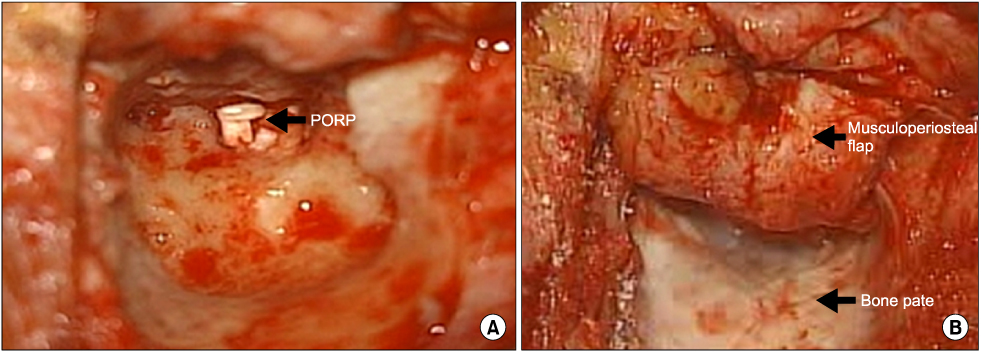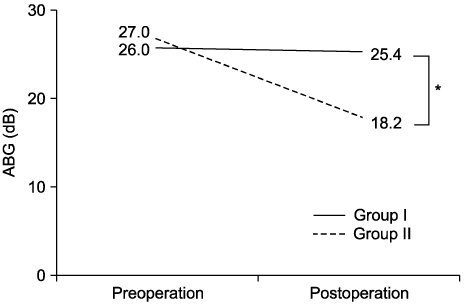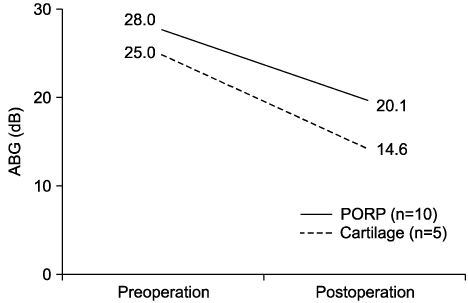Chonnam Med J.
2009 Aug;45(2):122-126. 10.4068/cmj.2009.45.2.122.
Comparison of Hearing Results by Type of Tympanoplasty with Mastoid Obliteration during Chronic Otitis Media Surgery
- Affiliations
-
- 1Department of Otolaryngology-Head and Neck Surgery, Chonnam National University Medical School, Gwangju, Korea. victocho@hanmail.net
- KMID: 2172272
- DOI: http://doi.org/10.4068/cmj.2009.45.2.122
Abstract
- Mastoid obliteration during chronic otitis media (COM) surgery could improve hearing results by enhancing the acoustic properties of the external auditory canal. The objective of this study was to compare postoperative hearing results by type of tympanoplasty with mastoid obliteration during COM surgery. Twenty-five COM patients (25 ears) underwent tympanoplasty type III during canal wall down (CWD) mastoidectomy and mastoid obliteration: 10 patients underwent classic tympanoplasty type III (group I), and 15 patients underwent columellarization between the tympanic membrane and the stapes head with a partial ossicular replacement prosthesis or cartilage (group II). Hearing results and complications were compared between the 2 groups. Postoperative air-bone gap (ABG) levels within 20 dB were 30% and 60% in group I and group II, respectively. Closure of the ABG was significantly better in group II than in group I (p<0.05). No serious complications were observed in either group. In CWD tympanomastoidectomy with mastoid obliteration, tympanoplasty using strut results in greater hearing improvement than does classic tympanoplasty type III.
Keyword
MeSH Terms
Figure
Reference
-
1. Palva T. Surgical treatment of chronic middle ear disease. II. Canal wall up and canal wall down procedure. Acta Otolaryngol. 1987. 104:487–494.
Article2. Gantz BJ, Wilkinson EP, Hansen MR. Canal wall reconstruction tympanomastoidectomy with mastoid obliteration. Laryngoscope. 2005. 115:1734–1740.
Article3. Hartwein J, Hormann K. A technique for the reconstruction of the posterior canal wall and mastoid obliteration in radial cavity surgery. Am J Otol. 1990. 11:169–173.4. Lee WS, Choi JY, Yang HD, Cho CH, Kim IS. Mastoid obliteration with bone paste and fat. Korean J Otolaryngol. 2001. 44:26–31.5. Wiet RJ, Harvey SA, Pyle MG. Canal wall reconstruction: A newer implantation technique. Laryngoscope. 1993. 103:594–599.6. Merchant SN, McKenna MJ, Mehta RP, Ravicz ME, Rosowski JJ. Middle ear mechanics of Type III tympanoplasty (stapes columella): II. Clinical studies. Otol Neurotol. 2003. 24:186–194.
Article7. Hartwein J. The acoustics of the open mastoid cavity (so-called "radical cavity") and its modification by surgical measures. I. Physical principles, experimental studies. Laryngorhinootologie. 1992. 71:401–406.8. Kim HJ, Shin MS, Cho YB, Cho Y, Kim JH, Lee JK. The effect of mastoid obliteration technique using superior based musculoperiosteal flap and autologus conchal cartilage. Korean J Otolaryngol. 2001. 44:1264–1269.9. Wullstein H. The restoration of the function of the middle ear, in chronic otitis media. Ann Otol Rhinol Laryngol. 1956. 65:1020–1041.
Article10. Juers AL. Preservation of hearing in surgery for chronic ear disease: a consideration of factors involved. Laryngoscope. 1956. 64:235–251.
Article11. Tos M, editor. Short-and long-term results with ossiculoplasty in cholesteatomatous ears. In Cholesteatoma and Mastoid Surgery. Proceedings Second International Conference. 1982. Amsterdam: Kugler;547–558.12. Artuso A, di Nardo W, De Corso E, Marchese MR, Quaranta N. Canal wall down tympanoplasty surgery with or without ossiculoplasty in cholesteatoma: hearing results. Acta Otorhinolaryngol Ital. 2004. 24:2–7.13. Shin SO, Jung WJ, Choi YS, Lee DW, Sim KH, Yoo SD. Usefulness of strut in ossiculoplasty during canal wall down tympanomastoidectomy. Korean J Otolaryngol-Head Neck Surg. 2006. 49:378–383.14. Lee WS, Choi JY, Song MH, Son EJ, Jung SH, Kim SH. Mastoid and epitympanic obliteration in canal wall up mastoidectomy for prevention of retraction pocket. Otol Neurotol. 2005. 26:1107–1111.
Article15. Takahashi H, Iwanaga T, Kaieda S, Fukuda T, Kumagami H, Takasaki K. Mastoid obliteration combined with soft-wall reconstruction of posterior ear canal. Eur Arch Otorhinolaryngol. 2007. 264:867–871.
Article16. House JW, Teufert KB. Extrusion rates and hearing results in ossicular reconstruction. Otolaryngol Head Neck Surg. 2001. 125:135–141.
Article
- Full Text Links
- Actions
-
Cited
- CITED
-
- Close
- Share
- Similar articles
-
- Surgery in the Only Hearing Ear
- The Effect of Mastoidectomy Combined with Tympanoplasty Type I on Postoperative Hearing in Chronic Otitis Media Patients Older than 65 Years
- A Short-Term and Long-Term Follow-up Study on Change of Hearing and Tympanogram after Tympanoplasty Type 1
- Clinical Analysis of Intact Bridge Mastoidectomy
- Outcomes of Modified Canal Wall Down Mastoidectomy and Mastoid Obliteration Using Autologous Materials





